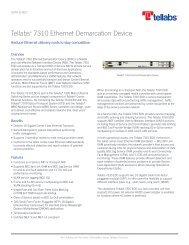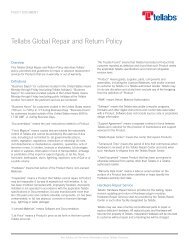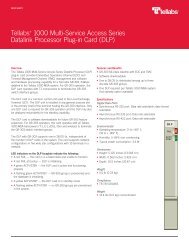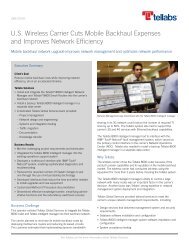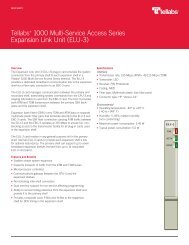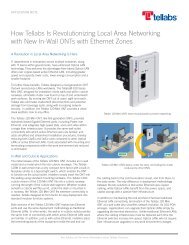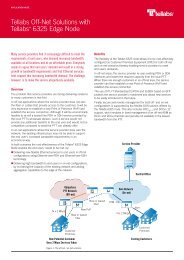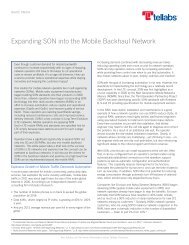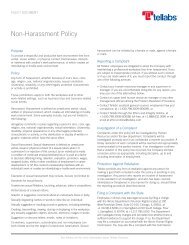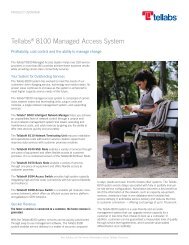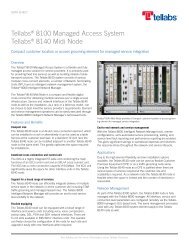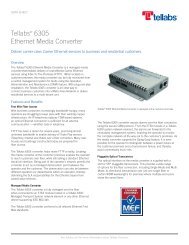Tellabs Insight Magazine - 2nd Quarter, 2013
Tellabs Insight Magazine - 2nd Quarter, 2013
Tellabs Insight Magazine - 2nd Quarter, 2013
Create successful ePaper yourself
Turn your PDF publications into a flip-book with our unique Google optimized e-Paper software.
Q2 <strong>2013</strong><br />
THE WORLD’S<br />
LARGEST PASSIVE<br />
OPTICAL LAN<br />
Sandia National Laboratories<br />
taps <strong>Tellabs</strong> for Optical LAN<br />
spanning 265 buildings<br />
Advance smart networks
4<br />
6<br />
11<br />
18<br />
LEADING EDGE<br />
<strong>Tellabs</strong> CEO and President Dan Kelly highlights our<br />
focus this month on optical networking and how the<br />
technology is transforming enterprise and service<br />
provider networks.<br />
UPLOAD<br />
People all over the world are using laptops and<br />
smartphones as “second screens” while they watch<br />
TV. Many Americans treat their mobile devices like<br />
their best friend.<br />
THE WORLD’S LARGEST PASSIVE OPTICAL LAN<br />
Sandia National Laboratories has built a passive<br />
Optical LAN using <strong>Tellabs</strong> equipment that connects<br />
265 buildings. By Sue Holmes, Sandia National<br />
Laboratories<br />
MIKE BIRCK’S LEGACY<br />
Our photo essay highlights the life and times of<br />
<strong>Tellabs</strong> Chairman Michael J. Birck. After leading<br />
<strong>Tellabs</strong> for 38 years, Birck retires May 1.<br />
By Joan Engebretson<br />
28<br />
32<br />
37<br />
GLOBE BUSINESS GETS AGGRESSIVE<br />
WITH CARRIER ETHERNET<br />
Philippines-based competitive carrier Globe Business<br />
was the first in Asia to receive Carrier Ethernet 2.0 certification.<br />
The company chose <strong>Tellabs</strong> equipment for a<br />
broad Metro Ethernet service expansion.<br />
By Joan Engebretson<br />
OTN SWITCHING MOVES INTO THE METRO<br />
As bandwidth demand grows, carriers are deploying<br />
Optical Transport Network switching in metro networks.<br />
Support for packet and TDM services helps carriers<br />
make the TDM-to-packet transition.<br />
By M.J. Richter<br />
THE RISE OF THE OPTICAL LAN<br />
Optical LANs are catching on at the high end of the<br />
enterprise market, says Jeff Heynen, directing analyst<br />
for Infonetics Research. In a Q&A with M.J. Richter,<br />
Heynen offers his views on Optical LAN opportunities.<br />
Subscribe to <strong>Insight</strong>: www.tellabs.com/insight<br />
<strong>Insight</strong> Q2 <strong>2013</strong> 2
One <strong>Tellabs</strong> Center<br />
1415 West Diehl Road<br />
Naperville, IL 60563 USA<br />
Phone: +1.630.798.8800<br />
Fax: +1.630.798.2525<br />
www.tellabs.com<br />
Now you can receive <strong>Insight</strong> magazine<br />
on your iPad or Android tablets,<br />
including videos<br />
President and CEO<br />
Daniel P. Kelly<br />
Editorial Board<br />
George Stenitzer<br />
Joan Engebretson<br />
Editor<br />
Joan Engebretson<br />
Editorial Contributors<br />
Joan Engebretson<br />
Sue Holmes, Sandia<br />
National Laboratories<br />
M.J. Richter<br />
Get the free “<strong>Tellabs</strong>” app<br />
in the iTunes App Store or at<br />
https://play.google.com/store/<br />
searchq=tellabs&c=apps<br />
Design<br />
Herring Design<br />
Cover photography by<br />
Randy Montoya and<br />
Dino Vournas<br />
Statements herein may contain projections or other forward-looking statements regarding future events, products,<br />
features, technology and resulting commercial or technological benefits and advantages. These statements are for<br />
discussion purposes only, are subject to change and are not to be construed as instructions, product specifications,<br />
guarantees or warranties. Actual results may differ materially. The following trademarks and service marks are owned<br />
by <strong>Tellabs</strong> Operations, Inc., or its affiliates in the United States and/or other countries: <strong>Tellabs</strong> ® , <strong>Tellabs</strong> and<br />
T symbol ® , and T symbol ® . Any other company or product names may be trademarks of their respective companies.<br />
Copyright ©<strong>2013</strong> <strong>Tellabs</strong>. All rights reserved. 74.2231E<br />
Subscribe to <strong>Insight</strong>: www.tellabs.com/insight<br />
<strong>Insight</strong> Q2 <strong>2013</strong> 3
LEADING EDGE<br />
The Optical LAN Revolution Begins<br />
Dan Kelly<br />
President and CEO<br />
One technology that’s transforming enterprise networks is <strong>Tellabs</strong> Optical LAN solution.<br />
Sandia National Laboratories has built the world’s largest passive Optical LAN,<br />
connecting 13,000 workstations in 265 buildings on its 13-square-mile campus.<br />
Replacing its copper-based LAN with <strong>Tellabs</strong> Optical LAN gives Sandia a simple,<br />
secure and scalable network that saves energy and money. In fact, Sandia expects to<br />
save $20 million over 5 years on its $15 million investment in Optical LAN (page 11).<br />
Much of that savings comes from reducing power consumption by 65%.<br />
How will the market for Optical LAN evolve Jeff Heynen of Infonetics Research<br />
addresses this question in a Q&A. In his view, Optical LAN can be a long-term solution<br />
for enterprises. “… Long term, we can go gigabit and beyond with fiber,” he notes<br />
(page 37).<br />
I’d like to congratulate our customer, Globe Business, the first carrier in Asia to<br />
achieve Carrier Ethernet 2.0 certification. Building on <strong>Tellabs</strong> technology, Globe has<br />
raised the bar in the Philippines. Over the past few years, Carrier Ethernet has become<br />
the dominant transport technology in the world, and Globe is fully prepared to capitalize<br />
on it (page 28).<br />
Since 1975, <strong>Tellabs</strong> co-founder and chairman Mike Birck has led <strong>Tellabs</strong> through<br />
many industry and technology changes. Back in the 1970s, Mike designed <strong>Tellabs</strong>’ first<br />
products himself. Over almost 4 decades, Mike led <strong>Tellabs</strong> as networks evolved from monopoly<br />
to competitive, analog to digital, wired to wireless, and narrowband to broadband.<br />
Subscribe to <strong>Insight</strong>: www.tellabs.com/insight<br />
<strong>Insight</strong> Q2 <strong>2013</strong> 4
LEADING EDGE<br />
On May 1, Mike will retire from <strong>Tellabs</strong>. Our special section on Mike’s career begins on<br />
page 18.<br />
User experiences are growing richer as mobile devices advance. Around the world,<br />
users are watching TV and accessing the Internet at the same time — giving rise to the<br />
“second screen” phenomenon. Americans even use their tablets as companions (page 6).<br />
The evolution of networks presents opportunities for our customers to win, through<br />
strategic thinking, better performance and lower costs. As our industry transforms, <strong>Tellabs</strong><br />
is here to help you succeed<br />
Sincerely,<br />
Dan Kelly<br />
President and CEO<br />
Subscribe to <strong>Insight</strong>: www.tellabs.com/insight<br />
<strong>Insight</strong> Q2 <strong>2013</strong> 5
UPLOAD<br />
By Joan Engebretson<br />
The 'second screen' goes worldwide<br />
Consumers are becoming digital multitaskers.<br />
Although more people are using digital Internet-based media, usage of traditional<br />
media such as TV remains high, says KPMG. The consulting firm surveyed 9,000 consumers<br />
in 9 countries. It found that 60% of metro Chinese consumers, 57% of metro<br />
Brazilians, 50% of North Americans, and 44% of Europeans and Australians watch TV<br />
while accessing the Internet by PC or laptop.<br />
That’s not counting people who watch TV while using a social networking site. Social-networking<br />
TV viewers include 36% of metro Chinese, 26% of Australians, 30% of<br />
North Americans, 37% of metro Brazilians and 25% of Europeans.<br />
WATCH TV &<br />
USE A SOCIAL NETWORKING SITE<br />
C O N T I N U E D<br />
&<br />
26%<br />
AUSTRALIA<br />
37%<br />
METRO BRAZIL<br />
36%<br />
METRO CHINA<br />
25%<br />
EUROPE<br />
30%<br />
NORTH AMERICA<br />
30%<br />
SINGAPORE<br />
Subscribe to <strong>Insight</strong>: www.tellabs.com/insight<br />
<strong>Insight</strong> Q2 <strong>2013</strong> 6
UPLOAD<br />
Computers, smartphones and tablets that consumers use while watching TV are<br />
now commonly known as the “second screen.” And content providers increasingly are<br />
taking the second screen into account as they develop new offerings.<br />
KPMG argues that content, devices and distribution channels need to be integrated.<br />
“It is unlikely that any single player can master all these components, making cooperation<br />
and collaboration a necessary approach,” the report advises.<br />
KPMG encourages stakeholders to experiment with the second screen. “There will<br />
have to be failures in order to find success,” says the report. “The winners will be those<br />
prepared to take risks and learn from their mistakes.”<br />
WATCH TV & ACCESS INTERNET<br />
VIA PC/LAPTOP (NOT FOR SOCIAL NETWORKING)<br />
&<br />
44%<br />
AUSTRALIA<br />
57%<br />
METRO BRAZIL<br />
60%<br />
METRO CHINA<br />
44%<br />
EUROPE<br />
50%<br />
NORTH AMERICA<br />
49%<br />
SINGAPORE<br />
Subscribe to <strong>Insight</strong>: www.tellabs.com/insight<br />
<strong>Insight</strong> Q2 <strong>2013</strong> 7
UPLOAD<br />
Pets may be feeling<br />
left out now that more<br />
Americans are using<br />
smartphones for<br />
companionship.<br />
Man’s New Best Friend<br />
Perhaps dogs are overrated.<br />
Many Americans today use their mobile devices for companionship, essentially treating<br />
the devices like a best friend, says Wakefield Research. It conducted a survey of more<br />
than 1,000 adult smartphone and tablet owners for cloud computing company Citrix.<br />
More than two-thirds of respondents (69%) said it had been one day or less since<br />
they last ate a meal without checking their device. And 64% said their primary reason<br />
for using their mobile devices was to “keep myself from being bored.”<br />
Like a best friend, an American’s mobile device may know things about him or her<br />
that no one else knows. Nearly half (46%) of respondents said they have used their mobile<br />
device to watch a television show in private that they would never watch with their<br />
friends. Top shows watched in private were “Pawn Stars,” “Storage Wars” and “The<br />
Real Housewives.”<br />
Americans also turn to smartphones and tablets for advice. Younger adults — including<br />
62% of Generation X and 54% of Millennials — said they trust “how to” advice<br />
from the mobile Web more than advice from their parents.<br />
Subscribe to <strong>Insight</strong>: www.tellabs.com/insight<br />
<strong>Insight</strong> Q2 <strong>2013</strong> 8
UPLOAD<br />
By 2018, ABI expects<br />
fiber-to-the-home to<br />
generate one-third of<br />
broadband service<br />
revenues.<br />
Global broadband speeds increase as profits decline<br />
Broadband services continue to see strong growth worldwide. But profitability isn’t<br />
keeping pace.<br />
Fixed broadband services — including DSL, cable and fiber-optic services — generated<br />
$188 billion globally in 2012, according to ABI Research. That's a 7% increase from<br />
2011. By 2018, ABI projects global broadband service revenues to reach $251 billion.<br />
Fiber-based services are the fastest-growing within the fixed broadband category,<br />
according to ABI. While fiber-based services grew 24% from 2011 to 2012, growth<br />
rates for DSL and cable broadband were 2% and 6%, respectively. By 2018, ABI<br />
expects fiber-to-the-home to generate one-third of broadband service revenues.<br />
Unfortunately, ABI notes that average revenue per broadband user has declined across<br />
all broadband technologies over the past few years. This trend is expected to continue<br />
as the majority of service providers offer lower prices to capture greater market share.<br />
Parks Associates notes similar trends, looking at global Internet and broadband growth<br />
on a household basis. By 2016, Parks expects 814 million households worldwide to<br />
have Internet service and 94% to have broadband — up from 650 million broadband<br />
households in <strong>2013</strong>. By 2016, 99% of Internet households in the U.S. and most<br />
Western European countries will have broadband, Parks predicts.<br />
While broadband speeds have increased, pricing for broadband services has remained<br />
flat, Parks says, yielding the same profit decline that ABI found. Moving forward, Parks<br />
believes that usage-based business models and tiered services will become more common.<br />
And service providers will turn to a multi-service strategy, leveraging broadband<br />
connections to support services such as home monitoring and advanced video,<br />
Parks says.<br />
Subscribe to <strong>Insight</strong>: www.tellabs.com/insight<br />
<strong>Insight</strong> Q2 <strong>2013</strong> 9
UPLOAD<br />
Visit <strong>Tellabs</strong> at these upcoming events:<br />
Sviaz Expocomm<br />
May 14-May 17<br />
Booth 82C60<br />
Expocentre Fairgrounds<br />
Moscow, Russia<br />
iPOP IP and Optical Networks <strong>2013</strong><br />
May 30-May 31<br />
TKP Otemachi<br />
Conference Centre<br />
Tokyo, Japan<br />
WDM & Next Generation<br />
Optical Networking<br />
June 17-June 20<br />
Grimaldi Forum<br />
Monaco<br />
“I have just one more question —<br />
will it make me happy<br />
Subscribe to <strong>Insight</strong>: www.tellabs.com/insight<br />
<strong>Insight</strong> Q2 <strong>2013</strong> 10
THE WORLD’S<br />
LARGEST PASSIVE<br />
OPTICAL LAN Sandia’s Optical LAN connects<br />
265 buildings and saves<br />
$20 million over 5 years<br />
By Sue Holmes, Sandia<br />
National Laboratories<br />
PHOTOS: RANDY MONTOYA<br />
<strong>Insight</strong> Q2 <strong>2013</strong> 11
OPTICAL LAN<br />
The fiber distribution system<br />
uses only part of the conduit<br />
and needs only a 2- by 3-<br />
foot cable box. “The frames<br />
go away, and the walls are<br />
bare and the tray empties,”<br />
said Sandia Senior Engineer<br />
Steve Gossage<br />
Sandia National Laboratories is a multiprogram laboratory operated by Sandia<br />
Corporation, a wholly owned subsidiary of Lockheed Martin Corporation, for the<br />
U.S. Department of Energy’s National Nuclear Security Administration. With<br />
main facilities in Albuquerque, N.M., and Livermore, Calif., Sandia has major R&D<br />
responsibilities in national security, energy and environmental technologies, and<br />
economic competitiveness.<br />
It also has become a pioneer in large-scale passive optical networks,<br />
building the largest passive Optical Local Area Network in the world.<br />
The network pulls together 265 buildings and 13,000 computer<br />
network ports and brings high-speed communication to some of the Labs’<br />
most remote technical areas for the first time. It will save an estimated<br />
$20 million over 5 years through energy and other savings and not having<br />
to buy replacement equipment. Sandia expects to reduce energy costs by<br />
65% once the network is fully operational.<br />
Fiber offers far more capacity, is more secure and reliable and is less<br />
expensive to maintain and operate than traditional LANs that use copper cables.<br />
An Optical LAN gives people phone, data and video services using half-inch fiber<br />
optic cables made of 288 individual fibers instead of the conventional 4-inch copper<br />
cables. Copper cables typically fill up underground conduits and require steel overhead<br />
racks as well as distribution rooms filled with separate frames for voice and data cables.<br />
The fiber distribution system uses only part of the conduit and needs only a 2- by<br />
3-foot cable box.<br />
“The frames go away, and the walls are bare and the tray empties,” said Sandia<br />
Senior Engineer Steve Gossage, who has spent his 36-year career at the organization in<br />
advanced information and network systems engineering.<br />
The national laboratory has always pushed for speed beyond the fastest transmis-<br />
Subscribe to <strong>Insight</strong>: www.tellabs.com/insight<br />
LAN: Local Area Network<br />
R&D: Research and<br />
Development<br />
<strong>Insight</strong> Q2 <strong>2013</strong> 12
OPTICAL LAN<br />
sion rate available, Gossage said. “When people were working in much slower data rates,<br />
kilobit-type rates at short distances, we were trying to get 10 times the distance and<br />
10 times the speed,” he said.<br />
Adopting fiber optics<br />
Sandia began looking at fiber optics early in the technology’s development because<br />
of its promise of higher bandwidth over longer distances. The Labs started converting<br />
from copper in the 1980s, first installing then-emerging fiber optics in a single building<br />
and bumping that facility to megabit speeds. “Today we’re way past that. We’re at<br />
10-gigabit-type rates and looking hard at 100,” Gossage said.<br />
After years of planning, Sandia completed a formal network plan in late 2008 and<br />
sought competitive bids the following year. Sandia selected <strong>Tellabs</strong> as the equipment<br />
vendor for the network, and Gossage and his colleagues simultaneously began to jumpstart<br />
the deployment of the fiber infrastructure and set up a test lab to validate equipment<br />
configurations and the performance of network functions. The technology began<br />
moving to desktops in 2011, and by the end of 2012, Sandia had converted more than<br />
90% of bulky copper cable to a fiber optic LAN.<br />
Sandia, which will spend about $15 million on the project, needs superb computing<br />
capability for the problems it tackles.<br />
“Whether it’s a materials science problem or modeling an event, we need a lot of<br />
data and a lot of processing capability,” Gossage said. “We need to be able to see it,we<br />
need to be able to view it, and we need to be able to put teams together. This is a large<br />
laboratory, deeply stocked with scientists, engineers and test labs. For the analyses we<br />
get, the problems are not small and they’re not easy.”<br />
Sandia envisioned being able to use multiple wavelengths in a very high bandwidth<br />
single strand reaching the farthest tech areas. But decades ago, when Sandia began<br />
Subscribe to <strong>Insight</strong>: www.tellabs.com/insight<br />
“Whether it’s a materials<br />
science problem or<br />
modeling an event,<br />
we need a lot of data<br />
and a lot of processing<br />
capability.”<br />
— Steve Gossage,<br />
Senior Engineer,<br />
Sandia National<br />
Laboratories<br />
<strong>Insight</strong> Q2 <strong>2013</strong> 13
OPTICAL LAN<br />
putting in single-mode fiber to desks and adding underground fiber capabilities, the<br />
technology wasn’t quite mature enough to take advantage of fiber optics’ inherent<br />
multiple wavelengths and speeds.<br />
So Sandia continued to install the fiber optic foundation and waited while the technology<br />
developed, progressing quickly when commercial optical networks began<br />
supporting voice, data and video to large collections of homes and offices.<br />
“There weren’t that many unknowns for us because we had been thinking about<br />
ways to do this on a large scale for quite a while,” Gossage said. “We had already<br />
thought through what this might mean to us, what it might mean to our lifecycle costs<br />
and where the investments would be, and we were already pretty comfortable with fiber<br />
and the technologies that go with it.”<br />
Passive Optical LANs have<br />
greater range, reaching up<br />
to 30 kilometers, or 300<br />
times farther than copperbased<br />
LANs.<br />
Copper vs. fiber optics<br />
Buildings with conventional copper LANs have separate networks for phones,<br />
computers, wireless, security and so on. Fiber optics puts everything in a single network<br />
cable, eliminating a large number of power-consuming switches and routers and making<br />
the network simpler to operate and cheaper to install. Because fiber optic systems are<br />
more compact and efficient, energy and maintenance costs go down.<br />
“As we research and deploy new technologies, our main objectives are to enable<br />
the Labs’ mission, decrease life-cycle costs and if possible reduce our footprint on the<br />
environment. With the deployment of passive optical networks we have been able to<br />
meet and exceed all of these objectives,” said Sandia manager Jeremy Banks.<br />
Where a conventional LAN serving 900 customers requires a space the size of<br />
3 double ovens, an optical network serving 8,000 requires a microwave oven-sized<br />
space. Where a copper cable approach required Sandia to maintain and manage<br />
Subscribe to <strong>Insight</strong>: www.tellabs.com/insight<br />
<strong>Insight</strong> Q2 <strong>2013</strong> 14
OPTICAL LAN<br />
Sandia is recycling<br />
copper as it is replaced,<br />
which keeps tons of<br />
valuable material out<br />
of a landfill.<br />
600 separate switches in the field, Optical LAN allows the organization to operate a<br />
data center in one building with simple, standard ports to reach the offices. Because<br />
fiber optics reach beyond the 100-meter radius that once was the standard from a wiring<br />
closet to a desktop, remote areas such as the National Solar Thermal Test Facility have<br />
high-speed communications for the first time.<br />
The only copper wire for most of Sandia today is a short connection from the wall<br />
to the desktop. Everything behind the wall is fiber.<br />
Moving away from copper wasn’t easy. It required new technology for the core communication<br />
system and made Sandia its own network provider, Gossage said. He<br />
credited a central team of about 10 people across Sandia who worked together throughout<br />
2011, plus sub-teams totaling about 40 people. The teams included people from<br />
engineering design, information technology, network systems, computing, facilities, and<br />
security as well as people in the field pulling cable and connecting ports.<br />
“Thank you is just not quite enough when you see people working that hard for that<br />
long to assist in change, because change is hard and worrisome and disquieting,”<br />
Gossage said.<br />
Still to come<br />
Sandia is recycling copper as it is replaced, which keeps tons of valuable material<br />
out of a landfill. And the estimated $80,000 the organization will get for the copper<br />
will offset some of the fiber optic costs.<br />
The Labs also must turn off hundreds of switches before potential energy savings<br />
can be fully realized. That will take some time because it depends on staffing and other<br />
factors, Gossage said.<br />
More change could be coming. A small trial is under way for voice-over-fiber —<br />
putting data and voice in one system rather than the two systems Sandia uses today.<br />
Subscribe to <strong>Insight</strong>: www.tellabs.com/insight<br />
<strong>Insight</strong> Q2 <strong>2013</strong> 15
OPTICAL LAN<br />
Fiber optical cable can<br />
provide sufficient bandwidth<br />
for 25 years or<br />
more.<br />
Testing shows Sandia can protect voice running through a congested circuit —<br />
what Gossage calls “a Mother’s Day test” — when everyone calls at the same time.<br />
The Gigabit Passive Optical Network standard that Sandia uses enables the organization<br />
to dedicate part of the bandwidth and give priority to selected traffic such as voice.<br />
That enables calls to go through even with heavy competition from data traffic.<br />
Sandia also is working with a small number of researchers who need more bandwidth<br />
than they’re getting. The Labs’ needs are ahead of the market but the organization<br />
is pushing for next-generation increases in speed, Gossage said.<br />
Communication speed improves every 5 to 8 years. With copper, each improvement<br />
required replacing large, heavy bundles of jacketed cable to re-engineer them to perform<br />
at the new speed, he said. Fiber optical cable can provide sufficient bandwidth<br />
for 25 years or more.<br />
“We change the wavelength, we change the modulation rate, we don’t get back in<br />
the ceiling, we don’t get back in the customer’s office,” Gossage said. “So our return<br />
on investment, our capital investment, our operational investment, the impact on our<br />
customers — everything gets better.” ■<br />
Subscribe to <strong>Insight</strong>: www.tellabs.com/insight<br />
<strong>Insight</strong> Q2 <strong>2013</strong> 16
OPTICAL LAN<br />
The world’s smallest:<br />
<strong>Tellabs</strong> Mini ONT<br />
By Joan Engebretson<br />
In the second quarter of <strong>2013</strong>,<br />
<strong>Tellabs</strong> will begin shipping the <strong>Tellabs</strong> ®<br />
100 Series Mini Optical Network<br />
Terminal — the world’s smallest ONT<br />
with Power-over-Ethernet.<br />
ONTs connect users, serving as the<br />
interface between the Optical LAN and<br />
end-user equipment.<br />
The <strong>Tellabs</strong> ® 120W ONT installs in<br />
office walls in a standard size outlet. It<br />
provides two Gigabit Ethernet interfaces<br />
with Power-over-Ethernet to the user.<br />
The <strong>Tellabs</strong> ® 120C ONT installs in<br />
standard cubicle raceways with the<br />
same interfaces and feature set as the<br />
<strong>Tellabs</strong> 120W ONT.<br />
Purpose-built for enterprise<br />
networks, <strong>Tellabs</strong> new Mini ONTs:<br />
• Reduce cabling requirements<br />
and exposure to damage or<br />
theft by eliminating ONTs on<br />
or under desks<br />
• Minimize the space needed in<br />
the communication closet<br />
• Reduce deployment costs by<br />
eliminating fiber jumpers and<br />
desk/wall mounts<br />
• Require no power or battery backup<br />
at the desktop because they are<br />
remotely powered from the<br />
communication closet.<br />
Compared with a conventional<br />
active Ethernet LAN, <strong>Tellabs</strong><br />
Optical LAN can save up to<br />
70% in total costs, lower power<br />
consumption by 80% and<br />
reduce space by 90%.<br />
<strong>Tellabs</strong> 120C ONT (above)<br />
installs in standard cubicle<br />
raceways. <strong>Tellabs</strong> 120W<br />
ONT (below) installs in a<br />
standard<br />
size outlet.<br />
ONT: Optical Network<br />
Terminal<br />
Subscribe to <strong>Insight</strong>: www.tellabs.com/insight<br />
<strong>Insight</strong> Q2 <strong>2013</strong> 17
MIKE BIRCK’S<br />
LEGACY<br />
Co-founder who led<br />
<strong>Tellabs</strong> for more than<br />
3 decades will retire<br />
By Joan Engebretson<br />
Entrepreneur Michael J.<br />
Birck co-founded <strong>Tellabs</strong> in<br />
1975 and designed the<br />
company’s first products.<br />
Over 38 years, <strong>Tellabs</strong> grew<br />
to become a $1 billion<br />
global company.<br />
<strong>Insight</strong> Q2 <strong>2013</strong> 18
MIKE BIRCK RETIRES<br />
Michael J. Birck<br />
and his team<br />
worked hard and<br />
enjoyed what they<br />
were doing to build<br />
a billion-dollar<br />
global company<br />
Back in 1975 a small group began gathering every morning to plan a new company.<br />
Their plan was to build telecom equipment for smaller North American phone<br />
companies.<br />
The new manufacturing company became <strong>Tellabs</strong>, which is a $1 billion global<br />
telecommunications company today.<br />
One of <strong>Tellabs</strong>’ original founders and the man who designed its original products<br />
was Michael J. Birck. Since <strong>Tellabs</strong>’ founding, Birck has served the company as<br />
either CEO or chairman, and often as both. After 38 years of helping to shape the<br />
company’s direction, Birck plans to retire this year.<br />
To get <strong>Tellabs</strong> started, Birck sold stock he held in AT&T and used his home to<br />
secure a loan. Two other founders sold their homes.<br />
“I didn’t have much AT&T stock and they didn’t have very grandiose homes,”<br />
recalls Birck. “We came up with $110,000 and we were able to secure a<br />
$50,000 loan from a local bank.”<br />
Birck’s children were school age. “I remember telling them we would<br />
be eating a lot of hamburgers and hot dogs over the next year because<br />
I wasn’t going to earn a salary,” comments Birck. But after 6 or 8<br />
months of casseroles, one of them asked after dinner, “What ever<br />
happened to the hamburgers and hot dogs”<br />
Several other members of the group of 6 also worked without pay<br />
for the first year. Fortunately the company was able to begin manufacturing<br />
and make some sales before the end of its first year.<br />
“We lost only $47,000 the first year,” Birck recalls. “That’s pretty<br />
remarkable when you think about it.”<br />
C O N T I N U E D<br />
Subscribe to <strong>Insight</strong>: www.tellabs.com/insight<br />
19
MIKE BIRCK RETIRES<br />
Over the years,<br />
<strong>Tellabs</strong> expanded<br />
internationally.<br />
A strong product heritage<br />
The company’s early products provided amplification and echo suppression. The<br />
product line focused on niche products that faced relatively little competition.<br />
By mid-1980 <strong>Tellabs</strong> had grown so large that the founders decided to take it public.<br />
Going public also enabled the early employee-owners to cash in some stock.<br />
In the 1990s the company introduced the <strong>Tellabs</strong> ® Titan ® 5500 Digital Cross-<br />
Connect System, one of the most successful telecom products ever. Customers bought<br />
more than $3 billion worth of Titan 5500s.<br />
Over the years, <strong>Tellabs</strong> expanded internationally. Today it’s focused on packet optical,<br />
mobile backhaul, Ethernet/IP and access solutions for a variety of telecom and<br />
Internet applications around the world.<br />
Committing heart and soul<br />
Two of <strong>Tellabs</strong>’ original founders cashed out and left the company shortly after it<br />
went public. Another, Ron Sproull, was killed in a plane crash in the early years. Chris<br />
Cooney, an original founder who headed up sales, remained with the company for many<br />
years. But after Cooney retired, Birck was the only original founder who remained with<br />
the company.<br />
It’s easy to see why Birck was in no hurry to retire. He truly enjoys going to work<br />
every day.<br />
“In addition to building a company we had a good time doing it,” says Birck.<br />
“People committed their heart and soul to it.”<br />
Undoubtedly, much of <strong>Tellabs</strong>’ success over the years has come from people who<br />
share Birck’s attitude toward work. That’s a legacy Birck hopes will remain as he plans<br />
a long-awaited retirement. Those plans include traveling with his wife and volunteer<br />
activities in his community.<br />
Subscribe to <strong>Insight</strong>: www.tellabs.com/insight<br />
<strong>Insight</strong> Q2 <strong>2013</strong> 20
MIKE BIRCK RETIRES<br />
The right mix<br />
<strong>Tellabs</strong>’ original founders<br />
met around a kitchen<br />
table. Birck, in red at<br />
left, was the president<br />
and was the company’s<br />
only “technical guy.”<br />
Moving clockwise,<br />
Ron Sproull headed up<br />
manufacturing. Chris<br />
Cooney headed up sales.<br />
Fred Weeks was vice<br />
president of marketing.<br />
John Santucci was the<br />
“creative guy” who came<br />
up with the <strong>Tellabs</strong><br />
name. Marty Hambel<br />
oversaw finances.<br />
A fun first year<br />
(Below, left) Virtually<br />
everyone who worked<br />
for <strong>Tellabs</strong> the first year<br />
celebrated Halloween<br />
together. The man in<br />
the mask of former U.S.<br />
president Richard Nixon<br />
illustrates the lighthearted<br />
spirit of the<br />
young company.<br />
(Below, right) At Christmastime,<br />
a <strong>Tellabs</strong><br />
tradition was for Birck<br />
to dress in red and greet<br />
employees. “I still have<br />
that shirt,” comments<br />
Birck. “It’s a little<br />
threadbare.”<br />
Subscribe to <strong>Insight</strong>: www.tellabs.com/insight<br />
<strong>Insight</strong> Q2 <strong>2013</strong> 21
MIKE BIRCK RETIRES<br />
Covering the country<br />
Recalling <strong>Tellabs</strong>’ sales<br />
team in the early days,<br />
“Fred and Chris would<br />
load up their cars,” Birck<br />
says. “Fred would go east<br />
and Chris would go west.<br />
They slept in their cars<br />
more than once in those<br />
early days.” The company<br />
initially targeted the<br />
2,000 or so independent<br />
U.S. phone companies<br />
that weren’t part of the<br />
AT&T Bell System, which<br />
served the vast majority<br />
of the United States.<br />
Later, <strong>Tellabs</strong> made inroads<br />
with large carriers<br />
in North America and<br />
around the world.<br />
Getting the word out<br />
<strong>Tellabs</strong> started publishing<br />
an employee newsletter<br />
during its first year.<br />
Bob Pershing (back row,<br />
second from right) joined<br />
the founders as director<br />
of engineering.<br />
The “technical guy”<br />
Birck adjusts a program<br />
amplifier, one of <strong>Tellabs</strong>’<br />
early products. In those<br />
early days, Birck says,<br />
“I was in the lab most of<br />
the time.”<br />
Subscribe to <strong>Insight</strong>: www.tellabs.com/insight<br />
<strong>Insight</strong> Q2 <strong>2013</strong> 22
MIKE BIRCK RETIRES<br />
At home at headquarters<br />
For many years <strong>Tellabs</strong><br />
was headquartered in a<br />
rented building in Lisle,<br />
Ill. “The tree in front<br />
was a kind of hallmark<br />
for us,” Birck says. “We<br />
had a lot of events under<br />
the shade of that tree.”<br />
Birck also liked the<br />
Lisle location because<br />
“We could bring customers<br />
there and they<br />
didn’t worry that we were<br />
spending money foolishly<br />
on facilities.” The<br />
company later opened<br />
a larger facility in<br />
Bolingbrook, Ill., before<br />
settling into its current<br />
location in Naperville,<br />
Ill., in 2001.<br />
Sharing their talents<br />
<strong>Tellabs</strong> has supported<br />
Habitat for Humanity,<br />
a volunteer organization<br />
that builds housing for<br />
disadvantaged people<br />
worldwide. Employees<br />
were given time off to<br />
work on this house in<br />
Joliet, Ill. “I went out<br />
and pounded nails with<br />
them for a while,”<br />
Birck recalls.<br />
Subscribe to <strong>Insight</strong>: www.tellabs.com/insight<br />
<strong>Insight</strong> Q2 <strong>2013</strong> 23
MIKE BIRCK RETIRES<br />
Wojo’s brainchild<br />
Bob Wocjinski, known<br />
as “Wojo,” spearheaded<br />
development of the<br />
<strong>Tellabs</strong> Titan 5500<br />
Digital Cross-Connect<br />
System. Before the<br />
5500, <strong>Tellabs</strong> had<br />
offered lower-capacity<br />
digital cross-connects<br />
designed for T-1 circuits.<br />
“Bob came to me one<br />
day and said, ‘We have<br />
to have a DS-3 or higherspeed<br />
version’,” recalls<br />
Birck. “He said it would<br />
cost $8 million to<br />
develop and take 3 years.<br />
It took $40 million and<br />
6 or 7 years.” Not everyone<br />
agreed <strong>Tellabs</strong><br />
should pursue the product.<br />
But Birck was convinced<br />
Wojo and his<br />
team could pull it off.<br />
“It turned out to be the<br />
biggest success we ever<br />
had,” says Birck. “It became<br />
the standard of<br />
the industry for quite a<br />
number of years.”<br />
Subscribe to <strong>Insight</strong>: www.tellabs.com/insight<br />
One of telecom’s most<br />
successful products<br />
The original sales<br />
brochure for the <strong>Tellabs</strong><br />
Titan 5500 Digital Cross-<br />
Connect System, which<br />
<strong>Tellabs</strong> continues to<br />
offer. Today, most of<br />
<strong>Tellabs</strong>’ revenue comes<br />
from Ethernet/IP,<br />
packet optical and<br />
access solutions.<br />
<strong>Insight</strong> Q2 <strong>2013</strong> 24
MIKE BIRCK RETIRES<br />
Proud moments<br />
(Upper left) Birck broke<br />
ground for <strong>Tellabs</strong>’ current<br />
headquarters in<br />
Naperville, Ill., in April<br />
2000.<br />
(Upper right) <strong>Tellabs</strong>’<br />
annual sales hit nearly<br />
$100 million as Cooney<br />
and Birck celebrated the<br />
company’s 10th anniversary<br />
in 1985.<br />
(Lower left) <strong>Tellabs</strong>’<br />
board of directors in<br />
1986 included (left to<br />
right) Michael J. Birck,<br />
president, <strong>Tellabs</strong>, Inc.;<br />
Frederick A. Krehbiel,<br />
executive vice president,<br />
Molex Incorporated;<br />
Paul M. Wythes, general<br />
partner, Sutter Hill<br />
Ventures; Robert P.<br />
Reuss, chairman and<br />
CEO, Centel Corporation;<br />
Henry F. McCance,<br />
general partner,<br />
Greylock Partnerships.<br />
(Lower right). Birck<br />
refers to <strong>Tellabs</strong>’ 25th<br />
anniversary celebration<br />
in 2000 as his proudest<br />
moment, when comedian<br />
Bill Cosby entertained<br />
employees and their<br />
spouses at McCormick<br />
Place in Chicago. Birck<br />
also visited <strong>Tellabs</strong> locations<br />
around the world.<br />
Subscribe to <strong>Insight</strong>: www.tellabs.com/insight<br />
<strong>Insight</strong> Q2 <strong>2013</strong> 25
MIKE BIRCK RETIRES<br />
Engaged employees<br />
Birck helped to create<br />
a culture at <strong>Tellabs</strong><br />
that encouraged all employees<br />
to feel engaged,<br />
as the Chicago Tribune<br />
reported in 1994. Birck<br />
is pictured with longtime<br />
<strong>Tellabs</strong> supervisor<br />
Annie Arredondo. Moving<br />
manufacturing offshore<br />
several years later was<br />
a difficult but necessary<br />
decision for <strong>Tellabs</strong><br />
to stay competitive,<br />
Birck says.<br />
Subscribe to <strong>Insight</strong>: www.tellabs.com/insight<br />
<strong>Insight</strong> Q2 <strong>2013</strong> 26
MIKE BIRCK RETIRES<br />
What goes around<br />
comes around<br />
(Above left) <strong>Tellabs</strong>’<br />
annual picnics and<br />
social events offered an<br />
opportunity to celebrate<br />
camaraderie – and give<br />
Birck a dunking. (Above<br />
right) Birck attempts to<br />
even the score, taking<br />
aim at Chris Cooney in<br />
the dunk seat. The right<br />
environment is one that<br />
supports open communications<br />
among all levels<br />
of management and employees,<br />
advises Birck.<br />
“Communication and<br />
having no artificial impediment<br />
to it are key to<br />
a successful organization,”<br />
he says.<br />
Subscribe to <strong>Insight</strong>: www.tellabs.com/insight<br />
Loving your work<br />
Birck and John Kohler<br />
enjoy a break in the<br />
cafeteria at <strong>Tellabs</strong>’ Lisle<br />
location. “People at this<br />
company had a lot of<br />
fun,” Birck says. “We<br />
became a significant<br />
player in telecom. And<br />
we did it with ordinary<br />
people who enjoyed what<br />
they were doing. It was a<br />
happening — how a very<br />
small company on the<br />
plains of Illinois became<br />
a significant player in<br />
a large and global<br />
industry.” ■<br />
<strong>Insight</strong> Q2 <strong>2013</strong> 27
GLOBE BUSINESS<br />
GETS AGGRESSIVE<br />
WITH CARRIER<br />
ETHERNET<br />
Philippine competitive<br />
carrier becomes the<br />
first in Asia to achieve<br />
Carrier Ethernet 2.0<br />
certification with<br />
Metro Ethernet built<br />
on <strong>Tellabs</strong> technology<br />
By Joan Engebretson<br />
Jesus Romero, Head, Globe<br />
Business, tours the Network<br />
Operations Center, with<br />
Ralph Candiloro, Vice President<br />
& General Manager,<br />
<strong>Tellabs</strong> Asia-Pacific.<br />
<strong>Insight</strong> Q2 <strong>2013</strong> 28
ETHERNET<br />
Globe Business sees the new Carrier Ethernet 2.0 standards as a way to raise<br />
the bar in the Philippine telecom market.<br />
“The industry has become hypercompetitive with the merger of the dominant<br />
carrier and the third player in the industry,” said Jesus Romero. Romero is<br />
head of Globe Business, the corporate arm of the Philippines’ leading competitive<br />
carrier Globe Telecom.<br />
“There is also pressure for telecommunication companies to find fresh revenue<br />
streams as the market matures,” Romero said.<br />
Carrier Ethernet 2.0 is the latest set of standards from the Metro Ethernet<br />
Forum. It adds OAM features and provides class of service. In addition, it offers<br />
better interoperability and scalability. And it supports end-to-end management.<br />
Globe Business is the first service provider in Asia, and the fourth in the world,<br />
to achieve MEF CE 2.0 certification with its point-to-point E-Line (EPL and EVPL)<br />
and multipoint-to-multipoint E-LAN services.<br />
“The most important aspects of Carrier Ethernet 2.0 are class of service and service<br />
performance,” said Romero. “This will enhance and solidify the SLAs we provide our<br />
customers.”<br />
Staff working at Globe<br />
Telecom’s Network<br />
Operations Center<br />
OAM: Operations,<br />
Administration and<br />
Maintenance<br />
SDH: Synchronous<br />
Digital Hierarchy<br />
SLAs: Service Level<br />
Agreements<br />
First to market, again<br />
Globe Business previously offered Ethernet services delivered over SDH. The service<br />
provider was the first in the Philippines to be MEF-certified when it received MEF 9 certification.<br />
The company subsequently received MEF 14 certification, and most recently<br />
CE 2.0 MEF-certification.<br />
Ethernet bandwidth demand from Globe’s enterprise customers has been growing<br />
rapidly. Those customers increasingly need connectivity to data centers for business continuity<br />
and disaster recovery. They also want an Ethernet platform to support cloud services<br />
Subscribe to <strong>Insight</strong>: www.tellabs.com/insight<br />
<strong>Insight</strong> Q2 <strong>2013</strong> 29
ETHERNET<br />
“This new approach<br />
will improve deployment<br />
cost structure while<br />
optimizing use of bandwidth<br />
on our network.”<br />
— Jesus Romero, Head,<br />
Globe Business,<br />
tours the Network<br />
Operations Center<br />
CPE: Customer<br />
Premises Equipment<br />
RFP: Request for Proposal<br />
VoIP: Voice over<br />
Internet Protocol<br />
and to provide real-time capabilities required for VoIP and Web conferencing.<br />
Globe Business decided to deploy a structured Carrier Ethernet access network as<br />
an alternative to Ethernet-over-SDH. The goal was to position the company to<br />
address those customer requirements.<br />
“This new approach will improve deployment cost structure while optimizing use<br />
of bandwidth on our network,” explained Romero.<br />
Speeding up provisioning and troubleshooting<br />
When Globe Business looked for equipment for its new network, one requirement<br />
was to meet Carrier Ethernet 2.0 specifications. Another was quick and efficient<br />
provisioning and troubleshooting.<br />
Globe based its equipment selection process on an RFP. The company selected the<br />
top 2 vendors, who underwent testing based on MEF standards.<br />
“After the technical qualification, vendors went through commercial evaluation,”<br />
said Romero. “We chose <strong>Tellabs</strong> because they provided the solution we were looking<br />
for. And they passed technical and commercial evaluations.”<br />
Globe will install <strong>Tellabs</strong> ® 7305 Ethernet Demarcation Devices at customer sites.<br />
Romero believes those devices will help Globe achieve its troubleshooting and maintenance<br />
goals. He particularly likes the RFC 2544 test tool built into the <strong>Tellabs</strong> 7305<br />
EDD, enabling non-intrusive real-time testing. “With that and our new Carrier Ethernet<br />
network we will provide a better user experience,” said Romero.<br />
In the Globe Business Carrier Ethernet network, the <strong>Tellabs</strong> CPE connects to<br />
<strong>Tellabs</strong> ® 7325 Ethernet Edge Switches. Those switches, in turn, connect to <strong>Tellabs</strong> ®<br />
7345 Ethernet Aggregation Switches. Traffic in the core travels on an IP-MPLS network<br />
based on the <strong>Tellabs</strong> ® 8800 Series Smart Routers.<br />
All of this is managed through the <strong>Tellabs</strong> ® 8000 Intelligent Network Manager.<br />
Subscribe to <strong>Insight</strong>: www.tellabs.com/insight<br />
<strong>Insight</strong> Q2 <strong>2013</strong> 30
ETHERNET<br />
E-LAN predominantly<br />
appeals to banking,<br />
finance and government<br />
customers.<br />
Globe Business likes having a single management system for all of the products.<br />
“One advantage is enabling end-to-end service management for each customer<br />
circuit from any point in the network,” said Romero. “This helps us rectify service<br />
issues immediately using the <strong>Tellabs</strong> INM. And for Globe, this helps to cut costs as we<br />
do not need to send field engineers to manage the CPE.”<br />
Delivering 3 types of Ethernet services<br />
Globe Business uses the <strong>Tellabs</strong> Carrier Ethernet platform to support 3 types<br />
of Ethernet services. These include point-to-point E-Line and EVPL (Ethernet virtual<br />
private line) services and multipoint E-LAN services.<br />
The E-Line offering is popular with business process outsourcing companies and<br />
call centers. Global and local service providers also purchase the service on a wholesale<br />
basis. All of these customers need guaranteed bandwidth.<br />
E-VPL is mostly used by IT companies and by some service providers. “These are<br />
companies with multiple applications. They need to tunnel or converge everything into<br />
a single point,” noted Romero.<br />
E-LAN predominantly appeals to banking, finance and government customers.<br />
Those customers often have multiple locations that need to connect to a head office.<br />
“With this Carrier Ethernet network, we position ourselves to offer carrier-class<br />
Ethernet services,” said Romero. “The services will conform to the newest standards<br />
for Ethernet technology set by the MEF. And that assures our customers of our commitment<br />
to providing world-class and best-quality services.” ■<br />
Subscribe to <strong>Insight</strong>: www.tellabs.com/insight<br />
<strong>Insight</strong> Q2 <strong>2013</strong> 31
OTN SWITCHING<br />
MOVES INTO THE<br />
METRO<br />
Growing bandwidth<br />
demand drives<br />
carriers to extend<br />
Optical Transport<br />
Network switching<br />
beyond the network<br />
core. By M.J. Richter<br />
<strong>Insight</strong> Q2 <strong>2013</strong> 32
OTN<br />
OTN is defined in ITU-T<br />
Recommendation G.709.<br />
Optical Transport Network (OTN) switching isn’t just for long-haul networks anymore.<br />
The technology is moving gradually into the metro network as well.<br />
Several trends are paving the way.<br />
Wireline, wireless, video and data center traffic in metro networks is growing fast.<br />
And bandwidth requirements in the metro are moving toward gigabit services and beyond.<br />
To future-proof their networks, service providers are deploying next-generation<br />
DWDM and ROADM transport technologies. For efficiency, service providers are converging<br />
switching and transport technology to concurrently handle TDM and packet services.<br />
Deploying OTN switching can help service providers achieve 4 critical metro<br />
network goals:<br />
• Reduce transport cost-per-bit<br />
• Efficiently utilize optical spectrum<br />
• Deliver and manage a variety of higher-bandwidth services seamlessly,<br />
transparently, and with low-latency<br />
• Build in the flexibility necessary to support future services.<br />
OTN or the “digital wrapper” protocol<br />
OTN is defined in ITU-T Recommendation G.709. The OTN protocol allows service<br />
providers to transparently transport data rates and services from 1Gbps to 100Gbps.<br />
OTN “wraps” the client signal into an ODU payload for transport through the network.<br />
This preserves the native structure and management information of each individual client<br />
signal as it traverses the network. And that enables the service provider to monitor and<br />
manage each signal’s performance end to end.<br />
With OTN, multiple services can be multiplexed and switched into a single 10G or<br />
Subscribe to <strong>Insight</strong>: www.tellabs.com/insight<br />
DWDM: Dense Wavelength<br />
Division Multiplexing<br />
ITU-T: International<br />
Telecommunications<br />
Union – Telecommunications<br />
Standardization<br />
Sector<br />
OTN: Optical Transport<br />
Network<br />
ODU: Optical channel<br />
Data Unit<br />
ROADM: Reconfigurable<br />
Optical Add Drop<br />
Multiplexer<br />
TDM: Time Division<br />
Multiplexing<br />
<strong>Insight</strong> Q2 <strong>2013</strong> 33
OTN<br />
Without OTN switching,<br />
a carrier might waste<br />
a 10G wavelength to<br />
transport 1 gigabit<br />
of data.<br />
100G wavelength. And OTN adds robust SONET/SDH-like OAM functions to DWDM<br />
equipment.<br />
Finally, OTN is designed to provide resilient protected services.<br />
A case-by-case evolution into the metro network<br />
OTN switching enables an evolutionary migration to OTN, observes Brian Nagle. Nagle<br />
is the director of optical transport product line management at <strong>Tellabs</strong>.<br />
The metro network is challenging because it supports a mixture of traffic, Nagle explains.<br />
Traffic includes mobile backhaul, enterprise services, residential video and data<br />
center interconnection. And each traffic type has different requirements.<br />
“You’re connecting disparate customers in the access domain,” Nagle says. “You<br />
need to have seamless coexistence among these technologies, so you can handle all of<br />
them as the transport network evolves. OTN provides a method to handle this co-existence.<br />
And OTN switching provides the method to transport OTN payloads<br />
efficiently.”<br />
Why bring OTN switching to the metro<br />
OTN switching fits in with the industry’s shift to packet-based infrastructure supporting<br />
gigabit Ethernet and Fiber Channel. As higher-speed services grow, service providers<br />
need to efficiently transport those services.<br />
Without OTN switching, a carrier might waste a 10G wavelength to transport 1 gigabit<br />
of data. With OTN switching, however, the carrier can aggregate multiple connections<br />
onto that single 10G wavelength.<br />
In some ways, OTN is similar to SONET/SDH, explains Nagle. “SONET/SDH can aggregate<br />
STS-1s,” he observes. “OTN switching can aggregate 1-, 2.5- or 10Gbps services<br />
together into single wavelengths.”<br />
Subscribe to <strong>Insight</strong>: www.tellabs.com/insight<br />
OAM: Operations,<br />
Administration, and<br />
Maintenance<br />
SONET/SDH: Synchronous<br />
Optical Network/<br />
Synchronous Digital<br />
Hierarchy<br />
STS-1: Synchronous<br />
Transport Signal-1<br />
<strong>Insight</strong> Q2 <strong>2013</strong> 34
OTN<br />
“SONET/SDH infrastructure<br />
will continue<br />
to be the workhorse<br />
technology for transporting<br />
services with<br />
rates below 1 Gbps.”<br />
— Brian Nagle, Director<br />
of Optical Transport<br />
Product Line<br />
Management,<br />
<strong>Tellabs</strong><br />
Equipment is available today that can support 100G wavelengths. But Nagle says 10G<br />
wavelengths are the most common “unit of currency” in today’s metro DWDM networks<br />
because they are less costly. And that’s unlikely to change for some time.<br />
For now, 100G is mainly for large enterprise customers or for connecting core routers.<br />
These applications are best deployed via 100G transponders for wavelength services,<br />
Nagle says.<br />
A familiar look and feel<br />
Service providers also are finding other compelling reasons to deploy OTN switching in<br />
the metro.<br />
With OTN service providers can offer a point-to-point tunnel through their network with<br />
no modification to the payload or to payload headers. That provides greater transparency<br />
and lower latency. And that makes OTN attractive to enterprise customers involved in<br />
high-speed financial trading.<br />
Additionally, network technicians like the fact that OTN management has a similar look<br />
and feel to SONET / SDH management. And that reduces training expenses for<br />
service technicians.<br />
SONET/SDH and Ethernet still part of the metro mix<br />
OTN switching may not be the best technology for every application. SONET/SDH infrastructure<br />
will continue to be the workhorse technology for transporting services with<br />
rates below 1 Gbps, notes Nagle. And the migration off of this technology will take some<br />
time.<br />
Similarly, Ethernet continues to play an important role in metro infrastructure. It may<br />
be the preferred solution when service providers need to deliver multipoint virtual LAN<br />
Subscribe to <strong>Insight</strong>: www.tellabs.com/insight<br />
LAN: Local Area Network<br />
<strong>Insight</strong> Q2 <strong>2013</strong> 35
OTN<br />
services. It also gives service providers the ability to oversubscribe the network. And that<br />
may be appropriate for certain types of services.<br />
Adapt to evolving needs of metro network<br />
Engineers considered the metro service mix in designing the <strong>Tellabs</strong> ® 7100 Optical<br />
Transport System and <strong>Tellabs</strong> ® 7100 Nano OTS. Those products provide a single platform<br />
for metro ROADM networks that can switch SONET/SDH, Ethernet and OTN.<br />
Using that platform, service providers can lower their operational cost per bit,<br />
comments Nagle.<br />
“They can generate added revenues from new services,” he adds. “They have a flexible<br />
solution that can adapt to their evolving needs. And they can meet their constant need<br />
to efficiently deliver a multitude of services.” ■<br />
Engineers considered<br />
the metro service mix<br />
in designing the <strong>Tellabs</strong><br />
7100 Optical Transport<br />
System and <strong>Tellabs</strong> 7100<br />
Nano OTS.<br />
Subscribe to <strong>Insight</strong>: www.tellabs.com/insight<br />
<strong>Insight</strong> Q2 <strong>2013</strong> 36
THE RISE OF<br />
THE OPTICAL LAN<br />
Jeff Heynen, Directing<br />
Analyst of Broadband<br />
Access and Video for<br />
Infonetics Research,<br />
recently discussed<br />
with M.J. Richter his<br />
view of the evolving<br />
Optical LAN market.<br />
<strong>Insight</strong> Q2 <strong>2013</strong> 37
ANALYST Q&A<br />
“Many enterprises and<br />
a lot of commercial<br />
real-estate developers<br />
are wiring their buildings<br />
with fiber from<br />
the get-go.”<br />
— Jeff Heynen, Directing<br />
Analyst of Broadband<br />
Access and Video,<br />
Infonetics Research<br />
Richter: Although Optical LAN platforms have been available for more than 5 years,<br />
the enterprise market began to embrace this type of networking solution only in the<br />
last year or 2. Why<br />
Heynen: First of all, within the enterprise there’s a lot of concern now about power<br />
consumption. Active electronics obviously use far more power than passive equipment.<br />
The other thing is that the deployment of fiber cabling has reached the point<br />
where, if you are undergoing a modernization effort within the enterprise, it makes<br />
sense now to move from Cat 5 or Cat 6 cable to fiber. Many enterprises and a lot of<br />
commercial real-estate developers are wiring their buildings with fiber from the get-go.<br />
For any business that moves in there and that has some concern about energy<br />
consumption and overall operational costs, it makes sense to look at passive GPONtype<br />
technologies for the Optical LAN distribution. Certainly Cat 5 or Cat 6 can still<br />
give you gigabit speeds, but long term, we can go gigabit and beyond with fiber.<br />
Richter: Are any particular verticals leading the way with Optical LAN deployments<br />
Heynen: Right now, the market is at the very high end. We’re talking about a lot of<br />
U.S. government installations where speed of data transfer is absolutely critical. Security<br />
also is very critical. GPON and a number of these technologies offer advanced<br />
encryption service.<br />
Definitely the public sector is leading the way. Here in North America, as part of<br />
the broadband stimulus roll-outs, there have been smaller projects in cities —<br />
governments, libraries, etc. — where optical LAN technologies have been used.<br />
Also in these smaller towns, where usually the broadband-stimulus funds are<br />
going, typically there’s a main street or a business area. If you’re doing fiber to the<br />
Subscribe to <strong>Insight</strong>: www.tellabs.com/insight<br />
GPON: Gigabit Passive<br />
Optical Network<br />
LAN: Local Area Network<br />
<strong>Insight</strong> Q2 <strong>2013</strong> 38
ANALYST Q&A<br />
“I would say that the<br />
dominant vertical<br />
right now is the U.S.<br />
government and<br />
public spending.”<br />
— Jeff Heynen, Directing<br />
Analyst of Broadband<br />
Access and Video,<br />
Infonetics Research<br />
home, and you’re rolling out this GPON network, you might as well use it to pass your<br />
private enterprises as well. That’s on a very small scale.<br />
I would say that the dominant vertical right now is the U.S. government and<br />
public spending. The public sector usually has the kind of speed and security requirements<br />
that really demand this kind of change.<br />
Richter: Are any private-sector verticals beginning to adopt Optical LAN technology<br />
Heynen: Those that are modernizing with fiber are certainly looking at the<br />
technology. There hasn’t been widespread adoption yet. But at the end of the day, it’s<br />
something enterprises of all sizes will look at.<br />
Service providers’ customer support centers, along with large networking<br />
facilities, are perfect opportunities in different verticals for these technologies to gain<br />
a foothold. But it’s going to take time.<br />
Richter: What are the biggest hurdles Optical LANs face, in terms of displacing<br />
traditional active-Ethernet LANs<br />
Heynen: Number one is the status quo, the fact that many enterprises are happy with<br />
their existing switches.<br />
Number two is the lack of interest in upgrading to fiber. For a large percentage of<br />
businesses right now, Cat 5 or Cat 6 is just fine. Remember how many T1 connections<br />
are still out there providing business services. For Optical LAN technology to<br />
really reach critical mass in terms of private enterprises, it’s just going to take time.<br />
Subscribe to <strong>Insight</strong>: www.tellabs.com/insight<br />
<strong>Insight</strong> Q2 <strong>2013</strong> 39
ANALYST Q&A<br />
“In Asia you have<br />
densely populated<br />
cities, with business<br />
and residential mixed<br />
use, where you’re<br />
already running GPON<br />
fiber to the home.”<br />
— Jeff Heynen, Directing<br />
Analyst of Broadband<br />
Access and Video,<br />
Infonetics Research<br />
Richter: Is Optical LAN uptake stronger in some areas of the world than in others<br />
Heynen: North America is definitely leading, and then it’s a toss-up between Europe<br />
and Asia Pacific.<br />
North America is the early pioneer in the technology but, in terms of volume,<br />
I think Asia Pacific will become the largest market. There you have densely populated<br />
cities, with business and residential mixed use, where you’re already running GPON<br />
fiber to the home. It makes sense to offer that to businesses in an optical LAN-type<br />
environment. It’s so much less expensive to roll out fiber there because you’re able<br />
to hit 10 or 100 times [the number of customers] that you can when you run it to<br />
single-family homes or even office parks. ■<br />
Subscribe to <strong>Insight</strong>: www.tellabs.com/insight<br />
<strong>Insight</strong> Q2 <strong>2013</strong> 40
Is your LAN ready for<br />
tomorrow’s challenges<br />
Optical LAN boosts performance, saves energy and cuts costs<br />
Users need more bandwidth. Executives want lower costs.<br />
What to do<br />
Consider <strong>Tellabs</strong> Optical LAN.<br />
It outperforms copper-based LANs with higher throughput,<br />
higher security, higher availability and a longer life. While it lowers<br />
power consumption and costs.<br />
Learn more about <strong>Tellabs</strong> Optical LAN Solution:<br />
http://info.tellabs.com/OpticalLAN.html<br />
<strong>Insight</strong> Q2 <strong>2013</strong> 41




